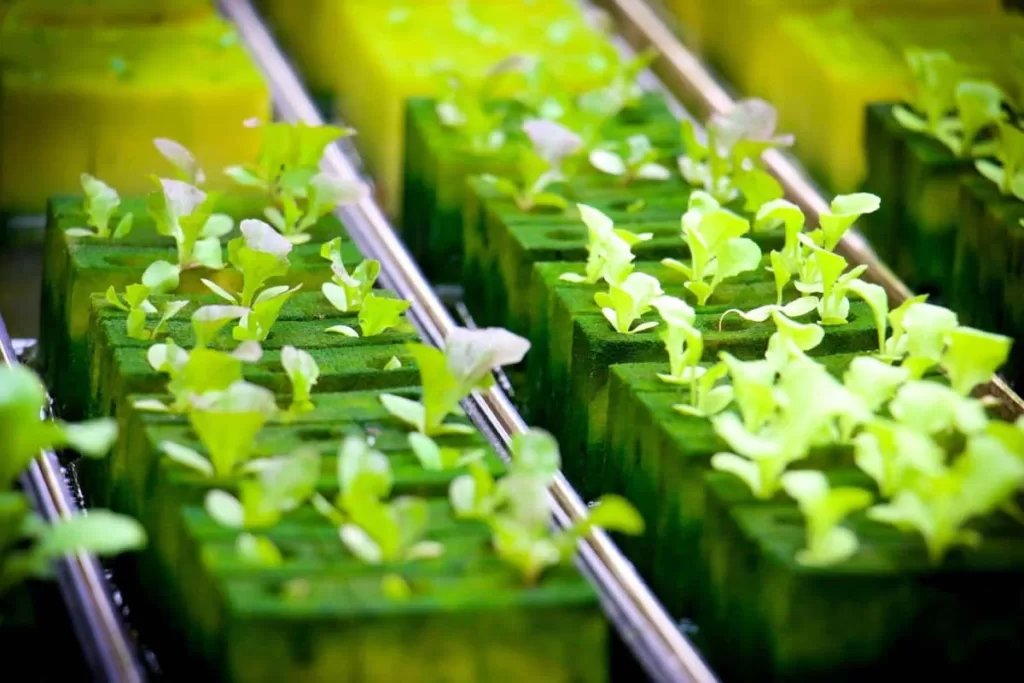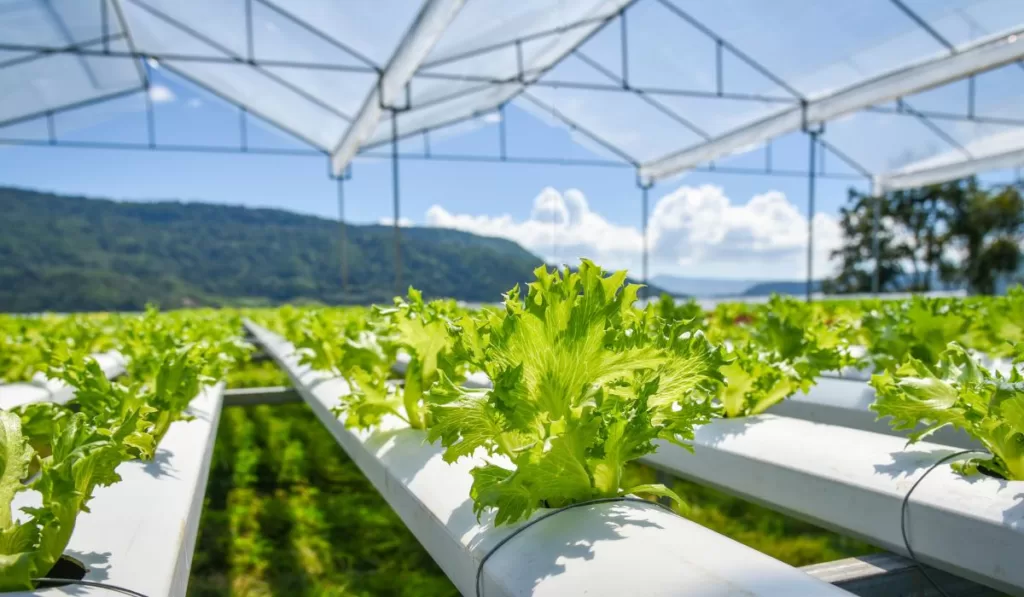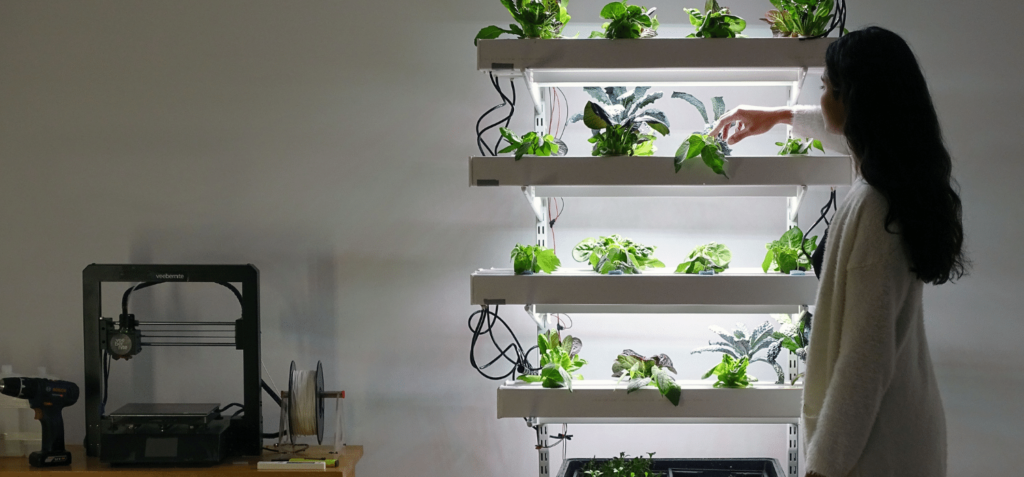To start a hydroponic farm at home, you will need to follow these general steps:
- Research and choose a hydroponic system that suits your space, budget, and plant growing needs. Some popular options include deep water culture, nutrient film technique, and ebb and flow systems.
- Gather the necessary equipment, such as grow lights, pumps, timers, and nutrient solutions.
- Set up your hydroponic system, following the instructions for your specific system.
- Choose plants that are well-suited for hydroponic growing, such as lettuce, herbs, and tomatoes.
- Monitor your plants regularly, checking for proper pH levels and nutrient levels in the solution. Make adjustments as needed.
- Provide proper lighting and temperature conditions for your plants.
- Harvest and enjoy your fresh, home-grown produce!
Keep in mind that hydroponic farming requires a significant investment in terms of time and money, so be prepared to put in the effort to ensure your plants thrive.
Table of Contents

Will hydroponic roots rot?
Hydroponic roots can rot if the conditions within the hydroponic system are not ideal. Some of the common causes of root rot in hydroponics include:
- Overwatering: This can lead to anaerobic conditions within the growing medium, which can cause roots to rot.
- Lack of oxygen: Hydroponic systems that do not provide enough oxygen to the roots can lead to root rot.
- High humidity: High humidity levels can promote the growth of mold and bacteria, which can cause roots to rot.
- Poor drainage: If the growing medium or hydroponic system does not have proper drainage, water can accumulate and cause roots to rot.
- Poor water quality: Water that is not clean or is not at the right temperature or pH can cause roots to rot.
- Pest and disease: Pests and disease can weaken the plant and cause the roots to rot.
To prevent root rot, it is important to ensure that the hydroponic system is properly set up and maintained, and that the plants are grown in the appropriate conditions. This includes monitoring the pH, nutrient levels, temperature, humidity and water quality, as well as providing adequate drainage and oxygen to the roots. Regularly inspecting the plants for signs of pests and diseases is also crucial.
Do hydroponic gardens use a lot of electricity?
Hydroponic gardens can use a significant amount of electricity, depending on the size and complexity of the system, and the type of equipment used. Some of the main electricity-consuming components of a hydroponic garden include:
- Grow lights: These are used to provide the plants with the light they need to grow, and they can consume a large amount of electricity, especially if they are high-intensity discharge (HID) or metal halide lights.
- Pumps: Hydroponic systems use pumps to circulate the nutrient solution and oxygenate the roots, which can also consume a significant amount of electricity.
- Climate control: Hydroponic systems often require heating, cooling, and ventilation to maintain the optimal temperature and humidity for plant growth, which can also consume a lot of electricity.
- Automation: Automated systems like controllers, timers, and sensors can also consume electricity.
The electricity consumption of a hydroponic garden can vary widely depending on the specific setup, but it is generally recommended to use energy-efficient equipment, such as LED grow lights, and be mindful of the power usage of the equipment.
Additionally, you can also consider using solar energy for your hydroponic garden and other alternative energy sources to minimize the electricity consumption.
What is the best hydroponic nutrient?
There is no one “best” hydroponic nutrient as different plants have different nutrient requirements. However, some popular hydroponic nutrient solutions include General Hydroponics Flora Series, Advanced Nutrients, and Canna. It is important to carefully follow the instructions on the nutrient package and consult with experts to ensure that the plants are getting the proper balance of nutrients.

What is the best hydroponic setup?
The best hydroponic setup depends on the specific needs of the plants being grown and the grower’s preferences. Some popular types of hydroponic systems include:
- Deep Water Culture (DWC): plants are grown in a container with their roots submerged in a nutrient-rich solution.
- Ebb and Flow (Flood and Drain): a tray with plants is periodically flooded with a nutrient solution and then drained.
- Nutrient Film Technique (NFT): plants are grown in a container with their roots exposed to a thin film of nutrient solution.
- Drip System: nutrient solution is delivered to the plants through a series of drippers.
- Aeroponics: plants are grown with their roots suspended in the air and misted with a nutrient solution.
It is important to research the different systems and consult with experts to determine the best option for your specific growing needs. Additionally, it’s important to consider the cost, space and equipment that would be required for each system.
Do you need an air pump for hydroponics?
An air pump is not always necessary for hydroponics, but it can be beneficial in certain systems. For example, in Deep Water Culture (DWC) systems, an air pump is used to provide oxygen to the roots by bubbling it through the nutrient solution. This can promote healthy root growth and prevent roots from becoming waterlogged.
Similarly, in Aeroponics systems, an air pump is used to provide oxygen to the roots by misting it through the nutrient solution. This can also promote healthy root growth and prevent roots from becoming waterlogged.
In other systems such as Drip, Ebb and flow, NFT, air pumps are not necessary as the nutrient solution is flowing around the roots providing them with enough oxygen. But in some cases, an air pump is used to oxygenate the nutrient solution before it reaches the roots.
In summary, while air pumps are not always necessary for hydroponics, they can be beneficial in certain systems, such as DWC and Aeroponics, to promote healthy root growth and prevent roots from becoming waterlogged.
How often should you change hydroponic water?
The frequency of changing hydroponic water depends on several factors, including the type of hydroponic system being used, the plants being grown, the nutrient solution being used, and the environmental conditions.
In general, it is important to monitor the pH and nutrient levels of the water regularly, and make adjustments as needed. The nutrient solution should be checked on a daily basis, and the pH should be checked at least once a week.
For example, in Deep Water Culture (DWC) systems, the water should be changed and the nutrient solution should be refilled every 1-2 weeks, or when the nutrient levels drop too low. In Ebb and Flow, NFT systems, the water should be changed every 2-4 weeks, depending on the plants and the environment. Drip systems, water should be changed at least once a month.
It’s important to keep an eye on your plants, if you see any sign of distress, or the water looks cloudy or discolored, it is a good idea to change the water and check the nutrient levels.
Overall, it’s important to monitor your hydroponic system regularly to ensure that the plants are getting the proper balance of nutrients, and that the water is not becoming contaminated.

When should I change hydroponic water?
There are several indicators that it may be time to change the hydroponic water, including:
- The water level is low and needs to be refilled.
- The pH level is out of range (usually between 5.5 and 6.5)
- The EC (electrical conductivity) or TDS (total dissolved solids) level is too high, indicating a build-up of dissolved minerals and nutrients.
- The water appears cloudy or discolored, indicating the presence of algae or other contaminants.
- The plants appear to be suffering from nutrient deficiencies or other issues.
- The water smells bad, indicating the presence of bacteria or other organisms.
It’s also important to keep in mind the life cycle of your plants, if you are growing plants that have a short life cycle, it’s more likely that you’ll need to change the water more often than if you were growing plants that have a long life cycle.
It’s generally a good idea to change the water and check the nutrient levels at regular intervals, such as every 1-2 weeks for Deep Water Culture (DWC) systems, every 2-4 weeks for Ebb and Flow, NFT systems, and at least once a month for Drip systems.
It’s important to keep an eye on your plants, if you see any sign of distress, or the water looks cloudy or discolored, it is a good idea to change the water and check the nutrient levels.
Is hydroponics healthier than soil?
Hydroponics can be a healthier way to grow plants when compared to soil, as it allows for better control of the nutrient intake, pH levels, and overall growing environment of the plants.
In a hydroponic setup, the plants are grown in a nutrient-rich solution, which allows for a more efficient uptake of nutrients. This can lead to faster growth, larger yields, and a higher quality crop when compared to soil-grown plants.
Additionally, hydroponics allows for better control of the pH levels, which can be critical for the growth and health of the plants. In soil, the pH levels can vary and be hard to control, while in hydroponics it can be adjusted more easily and accurately.
Additionally, hydroponics can be a cleaner and more sustainable way to grow plants, as it requires less water and space, and can be done in a controlled environment.
However, it’s also important to note that hydroponics requires more initial investment and technical knowledge, and if not done properly, it can lead to issues such as nutrient imbalances, pH fluctuations, and pest infestations. In summary, hydroponics can be a healthier way to grow plants when compared to soil, but it also requires more technical knowledge and attention.
Is there money in hydroponic farming?
Hydroponic farming can be a profitable venture for farmers and entrepreneurs. Hydroponics allows for year-round crop production, higher crop yields, and faster growth rates compared to traditional soil-based farming. This can lead to increased revenue and profits.
Hydroponic farming also allows for a wider variety of crops to be grown, including specialty crops that are in high demand and command higher prices, such as microgreens, herbs, and medicinal plants.
Additionally, hydroponics can be done in controlled environments, such as greenhouses, which can reduce costs associated with weather-related crop loss, and can also reduce the need for pesticides and other chemicals.
However, it’s also important to note that hydroponic farming requires a significant initial investment, including the cost of equipment, facilities, and technical expertise. Additionally, like any type of farming, the market demand and prices can fluctuate and be affected by various factors, such as weather, competition, and government regulations.
In summary, hydroponic farming can be a profitable venture, but it requires a significant initial investment and technical knowledge. It’s also important to conduct a thorough market analysis and business plan to evaluate the profitability and feasibility of a hydroponic farm.

Can you filter and reuse hydroponic water?
Yes, it is possible to filter and reuse hydroponic water. In a recirculating hydroponic system, the water is continuously circulated and filtered, ensuring that the plants always have access to fresh, nutrient-rich water.
The water is typically filtered through a variety of methods, including mechanical filtration, such as using a mesh filter, to remove solid debris, and biological filtration, such as using beneficial bacteria, to remove dissolved waste and other contaminants.
After filtration, the water is then returned to the hydroponic system, where it can be reused to grow the plants.
It’s important to note that in order to reuse the water, you will also have to monitor and adjust the nutrient levels and pH levels, as well as the TDS (total dissolved solids) levels, to ensure that the plants are getting the right amounts of nutrients.
Also, it’s important to keep in mind that even if you filter and reuse water, it’s a good idea to change the water and check the nutrient levels at regular intervals, such as every 1-2 weeks for Deep Water Culture (DWC) systems, every 2-4 weeks for Ebb and Flow, NFT systems, and at least once a month for Drip systems.
In summary, it’s possible to filter and reuse hydroponic water, but it requires a significant initial investment, technical knowledge, and regular monitoring and maintenance to ensure that the plants are getting the right amounts of nutrients and the water stays clean.
How many Litres of water does a hydroponic plant need?
The amount of water a hydroponic plant needs can vary depending on the type of hydroponic system, the crop being grown, and the environmental conditions.
In general, a hydroponic plant will require less water than a soil-grown plant, as the water is recycled and reused, and the plants are able to uptake nutrients more efficiently. However, different types of hydroponic systems have different water requirements.
For example, in a Deep Water Culture (DWC) system, plants are grown in a container of nutrient-rich water, and the roots are submerged directly in the water. A DWC system typically requires between 4-20 liters of water per plant, depending on the size of the container and the crop being grown.
In an Ebb and Flow system, the plants are grown in a container filled with a growing medium such as rockwool, and the roots are periodically flooded with nutrient-rich water. An Ebb and Flow system typically requires between 4-8 liters of water per plant, depending on the size of the container and the crop being grown.
In a Nutrient Film Technique (NFT) system, the plants are grown in a container filled with a growing medium such as rockwool, and the roots are periodically flooded with nutrient-rich water. An NFT system typically requires between 2-4 liters of water per plant, depending on the size of the container and the crop being grown.
In a Drip system, the water is delivered to the plants through a series of emitters, and the water is delivered directly to the roots of the plants. A Drip system typically requires between 1-3 liters of water per plant, depending on the size of the container and the crop being grown.
It’s important to note that these are approximate values and the water requirements may vary depending on the environmental conditions, such as temperature, humidity, light, etc. Also, the water requirements may change over time, as the plants grow and develop.
In summary, the amount of water a hydroponic plant needs can vary depending on the type of hydroponic system, the crop being grown, and the environmental conditions. It’s important to monitor the water usage and adjust as needed.





